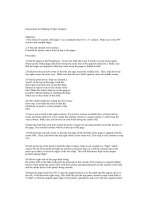How to teach a listening lesson pdp
Bạn đang xem bản rút gọn của tài liệu. Xem và tải ngay bản đầy đủ của tài liệu tại đây (2.02 MB, 2 trang )
physique relizane www.physique48.org
- Pre-listening (P) – During/While listening (D) – Post-listening(P)« Listening lessons »
A Listening lesson plan is made of the following steps:
{Pre-listening (P) – During / While listening (D) – Post-listening(P)}
Pre-Listening :
The teacher builds schema and introduces new language as needed.
Use pre-listening activities to prepare students for what they are going to hear or view.
The activities chosen during pre-listening may serve as preparation for listening in several ways. During
pre-listening the teacher may :
Assess students’ background knowledge of the topic and linguistic content of the text.
Provide students with the background knowledge necessary for their comprehension of the listening passage or
activate the Existing knowledge that the students possess;
Clarify any cultural information which may be necessary to comprehend the passage;
Make students aware of the type of text they will be listening to, the role they will play, and the purpose(s) for
which they will be listening;
Provide opportunities for group or collaborative work and for background reading or class discussion activities
Sample pre-listening activities:
Looking at pictures, maps, diagrams, or graphs
Reviewing vocabulaire or grammatical structures
Reading something relevant
Constructing semantic webs (a graphic arrangement of concepts or words showing how they are related)
Predicting the content of the listening text
Going over the directions or instructions for the activity
Doing guided practice
During- listening:
While-listening activities relate directly to the text, and students do them during or immediately after
the time they are listening. Keep these points in mind when planning while-listening activities:
If students are to complete a written task during or immediately after listening, allow them to read through it
before listening
Keep writing to a minimum during listening. Remember that the primary goal is comprehension, not production
Organize activities so that they guide listeners through the text :Students complete multiple tasks that move
from a general to specific focus in order to deepen their understanding of the text and develop specific listening /
reading skills, such as reading / listening for gist or specifics, skimming and scanning ,using context clues to predict
content
Use predicting to encourage students to monitor their comprehension as they list
Give immediate feedback whenever possible
Sample -while-listening- activities :
• Listening with visuals.
• Filling in graphs and charts.
• Following a route on a map.
• Checking off items in a list.
• Listening for the gist .
• Searching for specific clues to meaning.
• Completing cloze (fill-in) exercises.
• Distinguishing between formal and informal registers.
By Mr.Samir Bounab “ ”
physique relizane www.physique48.org
Post- listening: Use post-listening activities to:
Check comprehension,
Evaluate listening skills and use of listening strategies
Extend the knowledge gained to other contexts.
A post-listening activity may relate to a pre-listening activity
A post-listening activity must reflect the real-life uses to which students might put information they
have gained through listening.
Students complete activities that expand on content or language from the text using other skills
i.e. grammar, speaking, writing.
Mr. Samir Bounab « sambounabàhotmail.fr »









